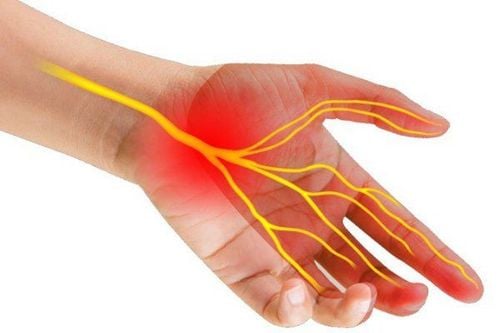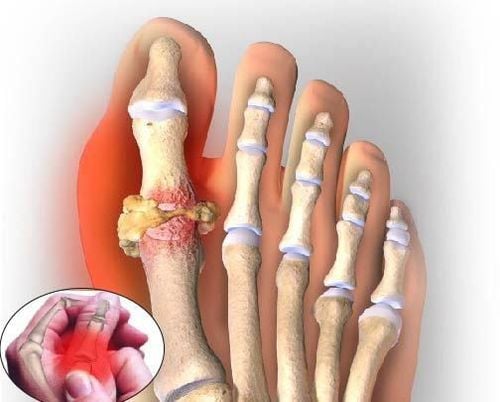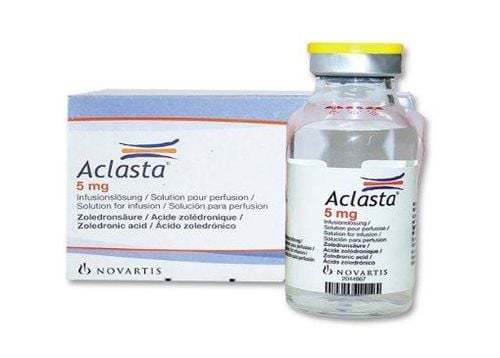This is an automatically translated article.
When the bones of a child's elbow are forced out of their normal position, it is called an elbow dislocation. This can cause pain from the elbow to the hand. The doctor may treat it by placing a splint on your child's elbow and letting your child's elbow return to its original position. So when the child falls on the elbow, will the child break a bone?
In this article, we will provide useful information to help caregivers promptly recognize the symptoms of fracture when a child falls on his elbow.
1. What is elbow joint? What is an elbow dislocation?
According to the medical definition, the elbow is the part that lies between two large and powerful structures that are the arm and forearm. In daily activities, the elbow keeps the function so that we can easily perform flexion and pronation movements of the forearm with ease.
In terms of the structure of the elbow joint, there are 3 areas of bony protrusion, which are places for tendons to attach. The lateral surface of the elbow has the superior lateral condylar process - the attachment site for the extensor muscles of the wrist and fingers. Inside the elbow, there is the superior process of the medial condyle, where the muscles that perform the wrist flexion and the fingers attach. Around the elbow joint there are also ligaments and joint capsule.
Elbow dislocation is a condition where the elbow joint is pulled and slipped out of its original position. These injuries usually don't last long, but if not treated in time, can affect a child's life. It is also the most common type of dislocation injury in children between the ages of 3 and 5. Dislocation injuries may be accompanied by fractures.
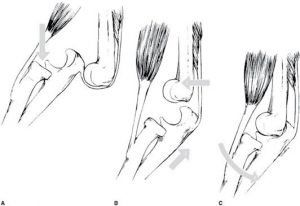
Trật khớp khuỷu tay có thể gây khó khăn khi vận động
Classification of elbow dislocations based on their location and complexity:
Simple dislocation. Complex dislocations associated with fractures or other problems. Posterior dislocation (accounting for 90% of dislocations). Anterior dislocation Lateral dislocation. Another possibility, if the child's elbow looks normal and the child does not appear to be in pain, but the child refuses to use his or her arm (there is a chance that the child will hug tightly to the body) this is called a "Nursemaid Elbow". . This means that the ligament surrounding the supracondylar process in the child's arm has slipped out of place. Nursemaid elbow is most common in children under 5 years of age. This is not a serious injury like a dislocation or fracture, but still requires a visit to a doctor.
2. Causes and risk factors of elbow dislocation
There are many factors that increase the risk of developing an elbow dislocation, including pulling the child up by hand. Pulling the hand or arm can put pressure on a child's elbow causing them to dislocate. Never do this, lift under the baby's armpit instead.
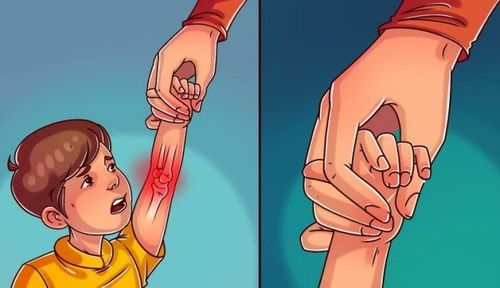
Kéo trẻ lên bằng tay dễ gây tổn thương khuỷu tay
3. Signs of elbow dislocation
Signs that will appear quickly when a joint is dislocated include:
Severe pain Dislocated joint with distortion A "pop" sound at the time of injury. Partially dislocated elbow presents with: Swelling, bruising, and pain where the ligament is stretched or torn. Stiffness, inability to bend the elbow. Numbness or weakness in the arm, wrist or hand. Children with a dislocated elbow may experience pain with movement of the elbow. Children with this condition often avoid moving the dislocated arm and keep the arm slightly bent next to the body. Elbow dislocations in children may not be obvious because the injuries do not cause obvious deformity in the hand or swelling in the elbow. Every child is different, so you may experience other symptoms not mentioned above. If in doubt, take your child to the doctor to check and get the best advice.

Đau khủy tay là biểu hiện rõ ràng nhất của trật khớp khuỷu tay
4. How do doctors diagnose elbow dislocation?
The doctors will first examine, observe and exploit the reason you brought your child to the hospital. Doctors then use X-rays to see if your child has broken his arm. If there is no fracture and the surrounding tissues are not damaged, the doctor will adjust the joints to return to the original anatomical position and fix the arm with a brace, then put the hand back to the functional position in front of the chest and try to secured with a triangle towel or forearm sling.
If the child is in too much pain, the doctor can give the child pain medicine or a little sedative while performing the manipulation.
The worst case scenario is that if the damage is more extensive then surgical intervention will be required.
5. Treatment of elbow dislocation injury
The first and most important thing parents should do is never try to fix a dislocated joint on their own as this can cause further damage to surrounding tissues, nerves and blood vessels. elbow joint. The treatment for an elbow dislocation injury is the same as that of a fracture. If possible, secure the child's arm by tying it to a piece of wood or cardboard, rolled up and just below the joint. To prevent further damage to the joint, splint it to the injured site rather than straightening them. In this case, two pieces of cardboard can be a good choice to be able to bend at the elbow.
Once the elbow is immobilized, take the child to the emergency room immediately. Do not give your child anything to eat or drink, in case he needs surgery. Because if there is food in the stomach, any surgical procedure can be delayed because vomiting under anesthesia is very dangerous. When the child is taken to the hospital, the child will have an X-ray of the arm to check for broken bones. If the bones are fine, but the tissues show signs of damage, doctors can put the bones back into their proper position and immobilize your baby's arm. They may splint the child's elbow in place. If necessary, the doctor will give the child a sedative during the surgery along with pain medicine. They will also ask parents to bring the child in for a follow-up check in a few days to assess the baby's arm condition. In addition, an MRI (magnetic resonance imaging) elbow joint can be taken to check in detail the soft tissues surrounding the joint such as cartilage, ligaments, capillaries and nerves of the child.

Chụp MRI trẻ em giúp chẩn đoán tình trạng tổn thương ở khủy tay
If damage occurs over a larger area, doctors will refer the parents to take the child to an orthopedic surgeon. Here, the baby will be adjusted so that the elbow joint returns to its correct position and fixed until the lesions are completely healed.
After returning home, parents should instruct children to try to raise their elbows whenever possible. For example, prop it up on a pillow when your baby is sitting down or lying down to help reduce swelling. Your doctor will also advise you to apply ice for about 15 minutes, several times a day for 48 hours after the elbow joint is immobilized.
At this age of children, parents cannot force them to sit still. Children need to be able to explore the world around them and that means some risks can happen to them, such as dislocated elbows. The child will experience pain and the joint may become deformed and swollen, making it difficult for the child to move the arm. This is a medical emergency because the surrounding ligaments, tendons, nerves, blood vessels, and muscles can be damaged. The best treatment for a child with a dislocated elbow is to immobilize the child's elbow and call an ambulance or take the child to the nearest medical facility. In particular, parents should not try to straighten the elbow on their own because this will only aggravate the injury.
When a child shows abnormal signs of health, parents can take the child to Vinmec Health system for timely examination and treatment.
Vinmec International General Hospital is a high-quality medical facility in Vietnam with a team of highly qualified medical professionals, well-trained, domestic and foreign, and experienced.
A system of modern and advanced medical equipment, possessing many of the best machines in the world, helping to detect many difficult and dangerous diseases in a short time, supporting the diagnosis and treatment of doctors the most effective. The hospital space is designed according to 5-star hotel standards, giving patients comfort, friendliness and peace of mind.
Please dial HOTLINE for more information or register for an appointment HERE. Download MyVinmec app to make appointments faster and to manage your bookings easily.
Reference source: babycenter.com; medicinenet.comSEE ALSO:
After a broken elbow, is the arm painful to stretch? Treatment of broken elbow bones Causes of elbow joint pain




